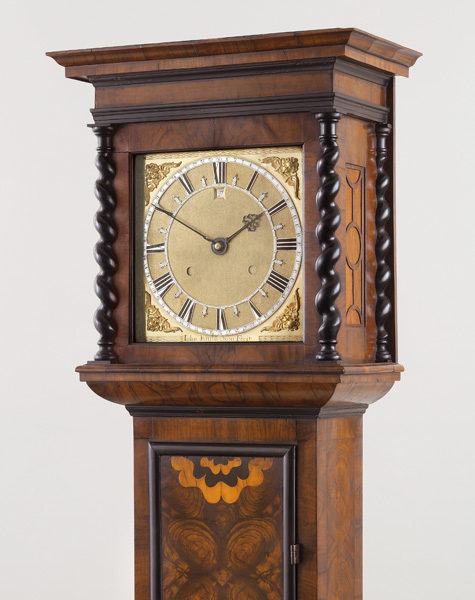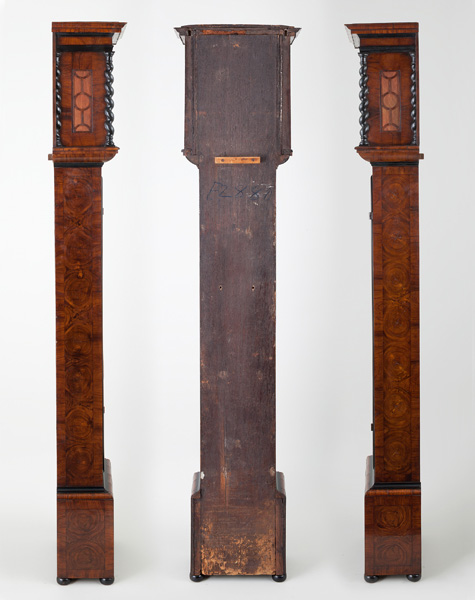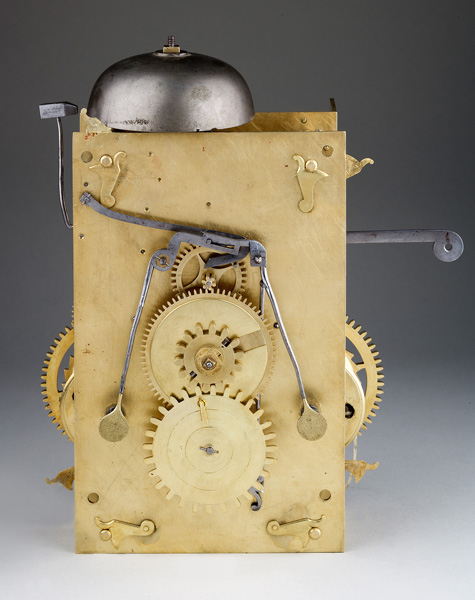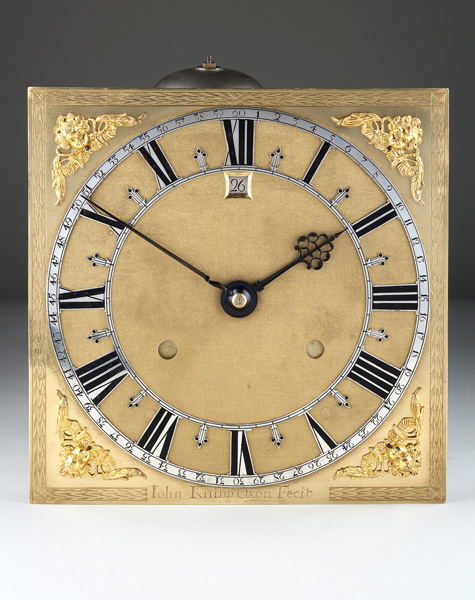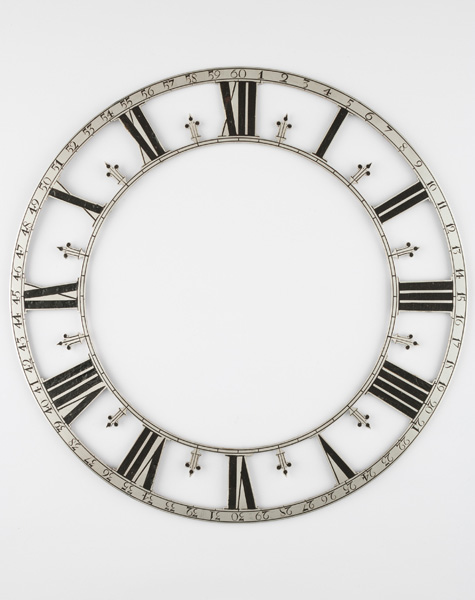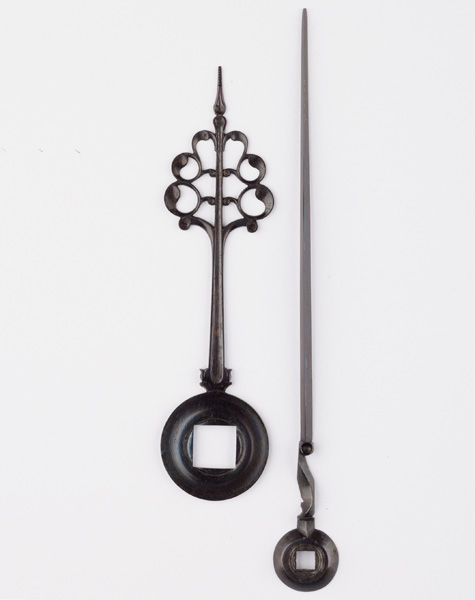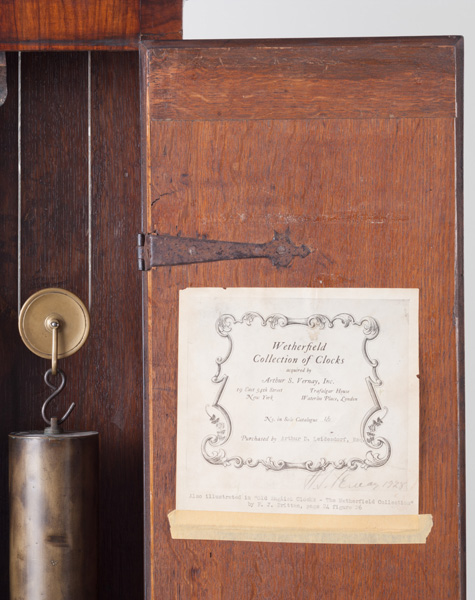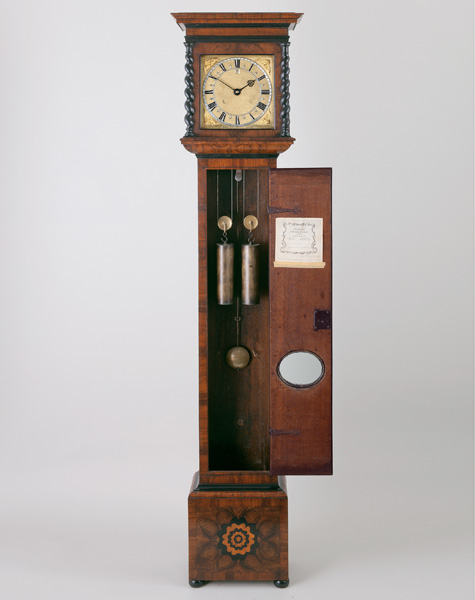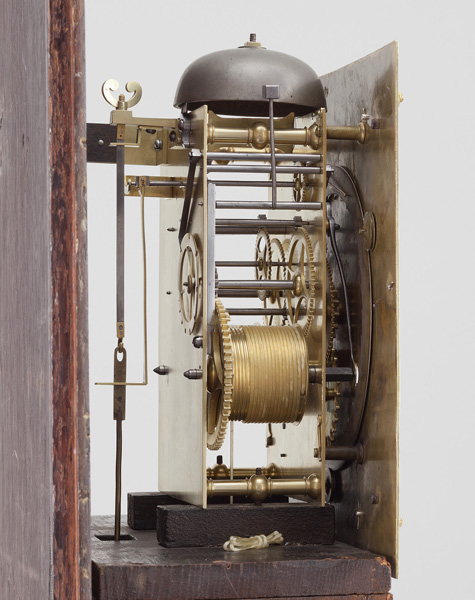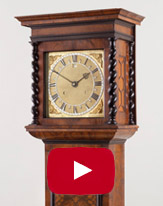[javascript protected email address]
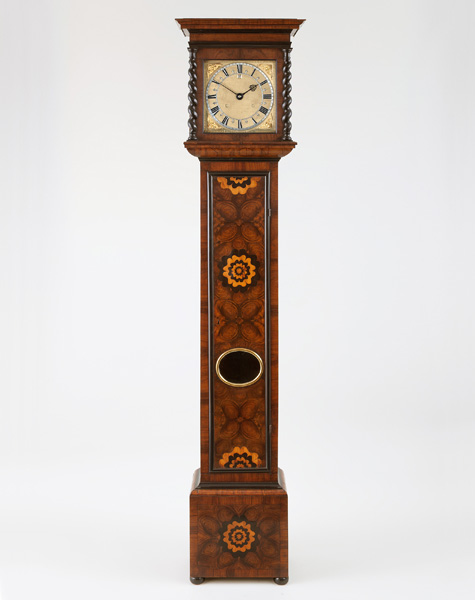
John Knibb, Oxford
Circa 1685
Sold
Height 6 ft 4� inches
A very rare silver-mounted olivewood, ebony and boxwood parquetry month-going longcase clock. CASE The elegant case is entirely veneered with olivewood oysters on an oak carcass, set into the veneers are geometric parquetry paterae flowers in boxwood and ebony. The plinth has restored bun feet and a fine quality moulding just beneath the trunk door, which has iron hinges and a central oval brass-framed lenticle. The rising hood has a convex throat moulding and is flanked by walnut twist columns surmounted by a silk-back pierced walnut sound fret. DIAL The fully latched 10 inch square dial is signed John Knibb Oxon Fecit at the base interrupting a wheatear-engraved border. The very delicate silver skeletonised chapter ring has Roman chapters with trident half hour markers and an outer concentric ring with every minute engraved; the centre of the dial has low-position winding holes and a calendar aperture just beneath chapter XII, the most unusual blued steel hour and minute hands are beautifully pierced and sculpted. It is believed that there are only two extant John Knibb of Oxford clocks with silver chapter rings: 1. A phase II table clock, with ebony case, silver mounts, velvet dial and a plain silver chapter ring 2. The present clock with its skeletonised chapter ring. MOVEMENT The month duration movement is in exceptionally original condition, with six latched and ring-turned baluster pillars; the trains have typical �fat� steel pinions and convex brass collets, the going train has anchor escapement with the original butterfly nut-suspended brass-rod pendulum with a further butterfly rating nut a few inches above the brass-jacketed pendulum bob; together with the original? matched pair of month-going brass weights. PROVENANCE The Wetherfield Collection, dispersed in 1928 by Vernay & Jussel, NY Sold to Arthur Liedersdorf, U.S.A. Sotheby�s, London, 28th June 1974, lot 164, sold for �22,500. To give the Sotheby�s 1974 price some context; in an earlier 1974 sale Sotheby�s sold Tompion table clock No. 205, for �12,000; and in the same sale another pre-numbered Tompion table clock sold for �16,000. Illustrated F.J. Britten, Old English Clocks, (The Wetherfield Collection), London, 1907, page 24, fig. 26 THE KNIBBS� WORKSHOP OUTPUT Whilst it is impossible to put an accurate number on how many clocks John Knibb produced, by scanning past auctions and AHS advertising we can assess that approximately 60 clocks by John Knibb were bought and sold between 1950 and 2000. By comparison approximately 250 clocks by Joseph Knibb were traded over the same period. SILVER CHAPTER RINGS There are only two clocks by John Knibb known to have silver chapter rings; 1. A phase II table clock, with ebony case, silver mounts, velvet dial and a plain silver chapter ring 2. The present clock with skeletonised chapter ring. PARQUETRY The case has a very distinctive and lovely parquetry inlay which was used on two other clocks, both signed Joseph Knibb. One of these (together with the present example) was in the Wetherfield Collection, and the other, a miniature longcase clock, stood for over two centuries in Preston Hall, a stately home in Scotland, before it was auctioned at Christie�s in 2013 JOHN KNIBB John Knibb (1650-1722), an exceptional clockmaker in his own right, was the younger brother of Joseph Knibb (1640-1721) to whom he was apprenticed in Oxford in1664. In1670, when his elder brother Joseph left for London, John took charge of the Oxford workshops and in1673, upon payment of a fine, he received the Freedom of the City of Oxford where he was to remain � and prosper, for the rest of his life It is undoubtedly true that Joseph and John�s workshops were closely allied. The Oxford workshops had a small output compared to Joseph�s prodigious London operation. Despite the low output the Oxford workshops still had ten apprentices between 1673 and 1715; this strongly suggests that the London business was outsourcing a considerable proportion of work to John�s Oxford workshops. Once Joseph had left for London in 1670 John�s limited production of Oxford clocks had a distinct, slightly provincial, style of their own. However a few of John�s clocks, including the present example, were of such outstanding quality that one can only come to the conclusion that they were made in London and retailed by John to one of his very wealthy clients. Another such examples is the small 12-inch ebony phase I table clock illustrated in R.A. Lee, The Knibb Family Clockmakers, plate 75) and a number of other very high quality phase III �London� table clocks, four of which are illustrated in The Knibb Family Clockmakers.

